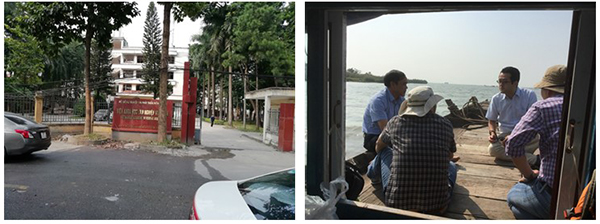Home > International Partnerships > Collaborative Research > Development of Technologies to Enhance the Functions of Forests for Disaster Prevention and Mitigation in Vietnam
Update:May 1, 2025
Main content starts here.
Development of Technologies to Enhance the Functions of Forests for Disaster Prevention and Mitigation in Vietnam

1. Partners
Vietnamese Academy of Forest Sciences, Viet Nam
2. Research Period
FY 2020-2024 Funded by the Forestry Agency, Japan
3. Lead Researcher
HIRATA, Yasumasa(Department of Forest Management)
4. Background
The Fifth Assessment Report of the Intergovernmental Panel on Climate Change points out that warming of the climate system is unequivocal and changes of land and water surface temperature, and sea level, among others, are observed. This progressing climate system change increases the frequency of extreme events. Indeed, intense rainfall has become frequent globally, and typhoons with extremely low atmospheric pressure have been increasing. Effective countermeasures against large-scale and high-frequency sediment-related disasters and severe storm-surge damages in coastal areas are required worldwide.
Recent disorderly land-use conversion from forest to farmland in mountainous and coastal areas has exacerbated damages caused by climate change. Poorly constructed roads in mountainous areas destabilize hillslopes and increase the number of sediment-related disasters. Once a sediment-related disaster occurs, it can damage the farmlands and houses, and even become life-threatening. Mangroves in coastal areas alleviate wave force from the ocean, while the root system prevents further erosion and flooding. When mangrove forests are cut down, these ecosystem services are lost.
In this study, we aim to contribute to the development and application of disaster prevention technology that utilizes the functions of forests in developing countries, by combining the latest information technology such as remote sensing and artificial intelligence (AI) with the forested hillslope conservation technology that Japan has accumulated.
5. Research Goal
The research goal is to develop forested hillslope conservation technology and remote-sensing methods for developing countries, highlighting disaster prevention and mitigation functions of forests. These methods will take into consideration the natural and social conditions of the target countries and the types of disasters expected.
6. Research Strategy
(1)Development of effective methods to implement the forested hillslope conservation technology of Japan
Taking into consideration local, natural, environmental, and social conditions, we will develop a method to effectively and appropriately apply the forested hillslope conservation technology of Japan that utilizes the disaster prevention and mitigation functions of forest ecosystems.
(2)Development of risk map using remote-sensing technology
By superimposing information such as landslide inventories, topography, geology, forest cover, and precipitation, we will develop a landslide risk map and a forest management map. AI technology will be used to compose and analyze these layers.
(3)Establishment of guidelines for conserving coastal mangrove ecosystems with high disaster resilience
For mangrove forests, which play an important role in mitigating and adapting to climate change, we will assess coastal disaster prevention and mitigation functions against storm-surge damages caused by sea-level rise and develop conservation measures based on scientific evidence.

Vietnamese Academy of Forest Sciences (Photo, left), and interviews with residents regarding mangrove planting (Photo, right)
7. Scientific Achievement
(1)Technical proposals and guidelines for forest conservation to maximize the use of forest functions for disaster prevention and mitigation were developed for Vietnam, based on slope failure risk maps and local needs in mountainous areas, and research reviews and field survey results in coastal areas.
(2)By holding international seminars on disaster prevention and mitigation utilizing forest functions for experts, side events at the Conference of the Parties to the United Nations Framework Convention on Climate Change, and training for technical experts, the results of the research were widely disseminated and contributed to international discussions.
8. Applications
Two technical manuals, “COCKBOOK for Forest-based Disaster Risk Reduction” and “Guide to Mangrove Conservation and Restoration - From the Perspective of Storm Surge Disaster Mitigation” have been prepared for the wide use of our research results. These manuals can be downloaded from the following URL (Japanese only).
9. Publications
(Peer-reviewed papers)
MORI Taiki, ONO Kenji, SAKAI Yoshimi: Testing the Tea Bag Index as a potential indicator for assessing litter decomposition in aquatic ecosystems, Ecological Indicators、152:110358 , 2023.8
Ono Kenji, et al.: Resistance to uprooting among mangrove trees at the Urauchi River Mouth, Japan, and Red River Delta, Vietnam: A mechanical analytical comparison based on an in-situ tree-pulling experiment, Japanese Journal of Forest Environment, 66(1):17-26, 2024.06.
(Conference presentations)
MICHINAKA Tetsuya, et al.: Analyzing Spatial and Temporal Patterns and Trends of Natural Disaster Damages in Vietnam, Proceedings of Joint International Symposium on Sustainable Forest Ecosystem Management (SFEM Taiwan 2024)、:4, 2024.08.
HIRATA Yasumasa, et al.: Evaluation of Disaster Prevention and Mitigation Functions of Mangrove Forests against Storm Surge by Remote Sensing, ForestSAT 2024 Abstract Book、:212, 2024.09.
MICHINAKA Tetsuya, et al.: Hotspot analysis of natural disaster damages in Vietnam, Abstract of 14th Annual Meeting of Kanto Forest Society:18-19, 2024.10.
MICHINAKA Tetsuya, et al.: Has economic growth been mitigating natural disaster damages in Vietnam? A hybrid approach of panel data analysis, Abstract of the Autumn Meeting of the Japanese Forest Economic Society, B9, 2024.11.
FURUICHI Takahisa, et al.: Uncovering sediment sources from spatial patterns of fluvial sediment transport in a mountain catchment in northern Vietnam, Japan Geoscience Union Meeting 2024、HGG02-P04 , 2024.05.
FURUICHI Takahisa, et al.: Spatial patterns of sediment discharge in a mountain catchment in northern Vietnam: What the data tell us about the impact of land-use along historical and contemporary contexts, American Geophysical Union Annual Meeting 2024、B53A-1722 , 2024.12.
Copyright © Forest Research and Management Organization. All rights reserved.
